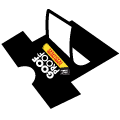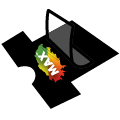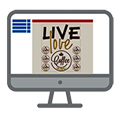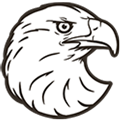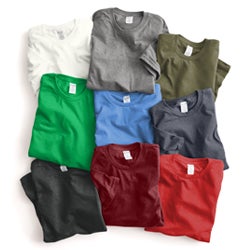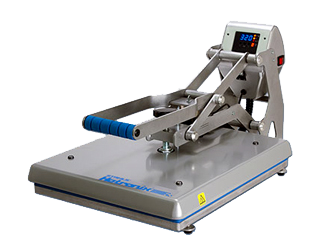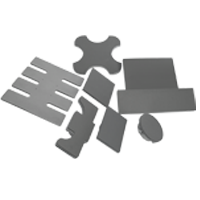How to Position Transfers
Browse Video Categories
Transfer Application | Artwork & Apparel | Easy View Tutorials | Webinars | Ordering Tips | Business | Heat Presses
With beginning heat pressers, the most common question is “How do I know where to position transfers on the shirt?” At this free online webinar we will address that challenge! If you apply heat transfer vinyl, screen printed, digital or rhinestone transfers, the method is the same.
You will learn:
- How to position transfers on a full front, left chest, a sleeve and a leg
- The pros and cons of four transfer positioning tools
- Unique positioning that can power profits
Video Transcript:
Good afternoon everybody! This is Andy Curtis coming to you from Transfer Express in beautiful Mentor, Ohio. I'm here to present to you how to position transfers.
Welcome everybody to the webinar. This is going to be a fun topic. I look forward to joining you for the next 45 minutes, give or take ish. We'll see how long we go with this one since this is a topic that everybody enjoys, that everybody gets something out of.
I think this is one of those topics that even if you're an old hat at this, if you've been doing this a long time or, you're brand new, I get the impression this is one of those topics that everybody can use a little bit of a leg up on once in a while, right?
So if you've joined me before, then welcome back. I'm glad to have you and it's a fun to see some names that I recognize in the audience. I've been doing this for a long time so some of you guys have joined me before. Thank you for coming back.
If this is your first time then I invite you to ask any questions you may have through the course of the webinar. There is a chat box in the bottom corner there. You see Delores is saying hi to everybody. That's where the chat box is. Hello Dolores, Lowe, Kylie. If you have any questions, type them in there.
I will do my best to see them and to answer them. If you have joined me though, you know that sometimes I talk a lot and I may miss your question. I don't do it on purpose, it just happens.
I have a helper behind the curtain who is going to assist in answering any questions that I might miss, so my helper will pop in.
There we go. There he is. He'll pop in there and answer any questions that I might miss, but feel free to correspond with me as much as you like during the course of the webinar. I'll do my best to correspond back.
We are recording this webinar as well since I know somebody is going to ask. We are recording it. It will go on our website at some point in the next couple days here after the webinar is downloaded and put back onto the website TransferExpress.com/webinars. So that's all the housekeeping I think. So feel free to let me know if you have any questions as we go.
We are going to talk about how to position transfers. I think we're gonna cover a little bit of everything here. We're gonna talk about sort of the unofficial ways. We're going to talk about the official ways of doing it. If you're somebody who likes rulers and t-squares and all that, I've got some great pictures. I even have a couple product recommendations for you guys in terms of tools to help you line stuff up, so I think we're gonna cover just about everything we possibly could here, guys.
So this should be informative for everyone. Thank you for joining me. Without further adieu, let's go ahead and get this started and move on to slide number one, shall we? And hello everybody, glad to see everyone saying hello in the chat box there.
All right - so positioning tools. We're going to talk about a couple different positioning tools. Of course, the eyes have it. The visual tips of how you center transfers. We're going to talk about how to do left chests. We're gonna talk about rulers. We're gonna talk about t-squares. We're going to talk about the Laser Alignment System.
If you have not seen our Laser Alignment System that we sell here at Transfer Express and the other Stahls' companies, you will be impressed. The Laser Alignment System is a lot of fun.
I am the kind of person where I've been doing this for such a long time that I can eyeball things. I tend to eyeball everything that I do, personally. We have a going joke here at Transfer Express. Our marketing manager, Sue, has been with the company for a very, very long time and she's trained many of us on how to use a heat press. She's been doing this for longer than anybody else in the building and I'm proud to say that I went to the Sue school of transfer positioning, but we're gonna talk about all these different techniques and all these different things that you can do to center your transfers or place your transfers.
We're gonna talk about ideas for different places to put transfers and all that good stuff.
So let's talk about fronts and backs. This is obviously the easy stuff. How to do it with your eyes. How to eyeball a front and a back. So there's two different techniques here. And I want to put this out there, before we even talk about these techniques, or before we really even talk about all this stuff, keep in mind that for these eyeball techniques here that we're going to talk about first that it is best for a squared design that if you do have a rectangular design you might have to tweak a little bit.
My recommendation here is before you even start the application process, you've got your t-shirt on your press, you've got your first transfer ready to go. Before you start positioning it and start your process, stop and actually look at where the transfer falls on the paper itself. Do you have a transfer that is rectangular and centered in the middle of your piece of paper? If so, you have some blank space on the paper above the transfer, so you don't want to necessarily use the top of the piece of paper. So pay attention to where your transfers actually are on the paper.
Now, if you have a square design, then this is obviously a moot point, not a big deal, but I'm assuming maybe I'm the only one that's done this before, but the first time I ever pressed an oval design, I didn't even think about it. I didn't pay attention to where the transfer was on the paper. I lined my top of my transfer paper up just like the pictures here on the slide, peeled it and realized "oh gosh, that oval is so far down on the paper now it's so far down on my shirt." So just pay attention to where you're your transfers are on the paper itself.
With that being said, so two ways to do full fronts or full backs. This works either way with your eyes. Now, the proper way to do this, and I will say this, the proper way to do it is the picture on the left hand side. This is, I think and I correct me if I'm wrong, but I think this is the way that most everybody learns right off the bat. I think this is the way that most people sort of do it at the beginning before you're good at the whole visual by eye without having to, you know, some of us, we can do this in our sleep at this point. But when you're new, I think everybody learns to do it this way. So per the picture I have on the left hand side of my slide, here you take your t-shirt and you draw an imaginary line down the middle of the t-shirt using the tag inside the neck as your middle point. So again, this is an imaginary line. Don't take a pencil and draw a line on your shirt. You draw an imaginary line down the center from the tag. So there's the center point of your t-shirt vertically.
Now, you're going to draw an imaginary line horizontally from armpit to armpit. Where those two lines intersect is the middle of your t-shirt front and that's where you center your transfer.
Now again, this is one of those things that the first couple times you do it, you get real precise. I've seen people that take the time to try and put a crease in their t-shirt to find that center point and if that's what makes you feel good about the first couple times, you do it when you're getting the hang of it, then by all means. Or sometimes, if you have purchased your t-shirts from a warehouse where they come folded in a certain capacity, you'll actually notice that the t-shirts come with sort of a crease down the middle a little bit. It makes that easier but either way, again, the idea is an imaginary line vertically down from the tag in the neck and then an imaginary line from armpit to armpit horizontally and that center point is where you center your transfer. So that's technique number one.
Technique number two is a little bit easier. That's on the right side of this slide here and I will admit - this is what I do. This isn't perfect, and like I said in my example a couple minutes ago, if you're not paying attention to the shape of your transfer, this one can actually get you in just a smidgen of trouble. But if you do have a square shape design and you have the transfer paper filled up, you don't have to worry about big blank spaces of paper then honestly you measure about say three to three and a half inches down from the neck of your shirt and that's where you start the top of your transfer paper.
Honestly, we call it the three finger method. You use three fingers. Now I'm a big guy, so I have chunky fingers, so I use my middle finger, my ring finger, and my pinky finger. I use those three fingers to judge the distance down from the neck that the top of my transfer should start at and again after some time, you get used to visualizing that you don't even need to use your fingers anymore. You can kind of see where to go with it. So another good way to center your full fronts and your full backs. If you've got a ruler and you're a ruler type person, three to three and a half inches - otherwise you just use three fingers or three fingers down from the neck. So those are the easy ones.
All right. I have a picture on the next slide and I want everybody to be honest here. Who's done this? Anybody want to fess up? I admit, I've done this before. Like I said, I wasn't paying attention to the shape of my transfer and I totally didn't pay attention I had an oval end up way too far down. No? There you go. Yeah okay. Exactly. Yeah, I think every decorator's done this at some point. Right, or maybe this is just a transfer thing.
Maybe embroiderers and screen printers don't have this happen ever. I don't know. Either way, the point is, you got to be careful when you're doing these visual things like this, because if you're not paying attention, if you go too quickly, then you're gonna end up with a belly print. And I just want to put it out there, we are the decorators of the world. We are the garment decorators, so if we wanted to, if we could send somebody down a runway somewhere in the world wearing one of these belly prints, we could make this popular, guys. Just saying, we could make this the style. Anyway, the point here is if you're not paying attention to what you're doing, if you're not careful, then you can end up with the belly print. What I want to recommend to everybody, is pay attention to where the ink is on the paper. If you've got a bunch of blank space between where the ink starts and where the top of the transfer page is, then you want to make up for that.
Okay, in the end I want my transfer to start about three inches, give or take, from the neck of my shirt. All right, so now if my transfer happens to be at the top of my transfer paper, then cool, that's easy. But if my transfer starts a little bit down on my transfer paper, then I want to make up for that somehow.
All right, Brad's got a good question here. Is this the distance for all sizes? And you know what? So honestly, it does and my helper has jumped in and answered here. Yeah, Brad, honestly it does work out this way. Generally, if I'm being honest, when I've done for XL and 5X t-shirts sometimes I even go just a smidge further down than that. Instead of three fingers, call it three-and-a-half fingers or three and a half to four inches. Then conversely, Brad, if you've got a teeny tiny itty bitty teeny shirt like an adult small or like a youth small or something like that, at that point, then you don't want to go three fingers down necessarily. That's where the other method, the first one we talked about, where you draw the line vertically down and then horizontally, that's when that becomes useful when you have shirts that are real tiny or shirts that are real huge. But for your general sizes for your adult mediums through your adult three X's, both of these suggestions are spot-on. No problem, easy peasy.
All right, so let's talk about numbers because this is one of those things that people get a little bit confused about sometimes. So numbers and names are actually super super simple. When you use Transfer Express, our numbers come pre-centered and pre-spaced on pieces of paper. So what you're looking at here in this photograph is actually a double digit number. It's two numbers, where all we've done is just put the two pieces of paper up next to each other. We've lined the corners of the numbers up so because they're pre centered and pre-spaced on their two individual pieces of paper, by lining those pieces of paper up you have created the perfectly spaced double digit number. Pretty slick, right?
Now, what you don't see in this picture is if we had an Express Name, one of our pre-spaced names, that we do here at Transfer Express. It's a screen printed player name. If you had an Express Name, which is just a rectangular strip of paper, you would put that strip, that Express Name, you'd sort of butt it up against the tops of the double-digit numbers, and again, it's pre-spaced and pre-centered on that strip. So you just kind of center it above and you have the bottom of the Express Name paper touch the top of the numbers, the paper the numbers are on, and again it all comes out pre-spaced, pre-centered. So once you've done that, once you've lined, whether you're doing just a double digit number or you're doing a number and a name, once you've lined up the papers, you use the same method we just talked about. You use your imaginary line down from the tag for the vertical line and then your armpit to armpit, you draw another imaginary line and again you center it the exact same way we just talked about. But then also, the three-finger method works here, too. If you want to go three fingers and again that's about three to three and a half, enough that your fingers are down from the collar of the t-shirt. Okay.
All right, let's go ahead and move on to the next slide here. This is a real thing guys. This is a real thing, so obviously you want to pay attention. Now, here's what I will say. If you're paying attention to what you're doing, it's a little bit harder to do the small of the back transfer like you see on the left hand side here. Full fronts are different because you've got a lot of paper to work with. You got a lot of ink on that paper but the numbers there's not a lot of extra paper going on so again as long as you're paying attention this one's a little bit harder to pull off. So again make sure you're watching how far down you're going there. Draw your imaginary line from vertically from the tank down draw your imaginary line from armpit to armpit and then center those numbers. Where those two lines intersect, and we can clearly see the person on the left, we did not do that - didn't draw any center lines there.
So all right so let's talk about left chest. Left chest is a little bit scarier for people. I think everyone gets nervous on their first left chest. This one is a, oh you know what Montana, hang tight - we're gonna talk about hoodies in just a second. So good question, good question but you're about three or four slides early. But left chest is one of those that's I think a little bit nerve-wracking for everybody because this one is a little bit easier to mess up if you're not careful. Full front or full back, guys, we have to remember that you're not going to have somebody run up to you with a micrometer and tell you that you're off a fraction of a fraction of a fraction to the left or to the right so this is one of those truths that I think every decorator gets to eventually, is you realize that it's not worth stressing yourself out to that level. Okay so in the end full fronts and full backs, it's a little bit harder to screw them up that drastically. Left chest is a little bit easier to mess up if you're not careful, but again, if you're paying attention, left chest are not that difficult.
So two different ideas for the left chest here. Two different ways to go about doing these. We got our imaginary lines on the left side here so you're going to center the transfer on the intersection of your two imaginary lines but this time your imaginary line is going to go, you're going to look at your collar and you're going to go as you're looking at it, not as you're wearing a shirt but as you're looking at a shirt sitting on your press. You're going to go to the far right side of the collar as you can see in the picture there and you're gonna draw an imaginary line straight down from the far right side of the collar. Remember, you're doing that as you're looking at it because when somebody puts that shirt on, it will be on the left as you're wearing it. On the right as you're looking at it. Okay, so the far right of the collar, you're gonna draw an imaginary line down straight down there and then another imaginary line from the bottom of the arm seam. Again from armpit to armpit. You're gonna draw an imaginary line there as well so you'll have an intersecting line that is off to the right hand side. That's where you're going to center your left chest transfer. This is where you're going to want to be cognizant of what the shape of your transfer is. If you have a very rectangular, a wide and short left chest image, then you want to watch how far to the left and right the transfer goes because you don't want to end up around on the armpit. I've got a good picture for you on the next slide to show you what that looks like. Oh see, yeah I hear you Montana. If you're not careful you can end up with a left chest transfer place you really don't want it to be. But anyway, so pay attention to the shape of your transfer. If it's a rectangle you have to be cognizant of where the longer parts of the rectangle are going to end up at.
Now if you are more of a measuring person, if you're somebody that likes to bust out a ruler and do this the ruler way, I've got two pictures here on the right-hand side of the slide that is a little bit more detail oriented for you. In this case, you're gonna measure seven and a half to nine inches down from the shoulder. Again it's the same thing you're gonna go to the far right of your collar. The far right of your collar or your neck if there is no collar. So you do a far right you're gonna measure seven and a half to nine inches down and then you're going to measure four to six inches from the center of the shirt to find your center point to put your left chest.
If you've got the polo as you can see here, the polo shirt gives you the perfect way to find the center of the shirt because guess why - those buttons break time it's under their shirt so polo shirts actually a little bit easier to do some these left chest. So Kylie's got a good suggestion here - I generally do about four fingers down from the collar so you don't get the logo on a bad spot on woman's shirt. There you go, four fingers is about right, give or take ish, maybe. But anyway, so the idea here is you've got two different methods depending on how you want to go about doing this. I personally use the method on the left hand side here. I don't like to bust out a ruler. I like to do things a little bit more visually when I'm doing a left chest. Here's the funny thing - I get so paranoid about placing left chests that I still take my finger and draw my imaginary line on my shirt with my finger straight down from the right side of the collar and then from armpit to armpit. For some reason, doing that makes me feel a little bit better about that. So kind of funny how that goes.
Now like I was saying, I'm sure we've all done this before. A couple of you already 'fessed up to it. I assume that Montana and Kylie, you guys have done this before, right? Anybody else ever had to happen too far to the side and you end up with a transfer under somebody's armpit? It's certainly not helpful, right? Yeah you can't see it if it's around their side, so you got to be careful. You don't want to go too far to the side with your left chest transfers. Actually the example in the photograph here is a good example of it because this is a very rectangular design. It's very short, it's very wide, so again you want to find your center point but you want to be careful how far left and right you go, how far side to side.
Sometimes, even though you've located your center point, in my personal opinion when I locate my center point, if I'm doing a rectangular design sometimes I do nudge it to the left just a smidgen. Yeah, I like to nudge it a smidgen to the left just to avoid, again, only if it's a rectangle. If you have a square-shaped left chest, I don't think this is necessary. Square-shaped left chest - you just find the center point like we've been talking about and wham-bam, you can be done. It's when you have a rectangle you have to be just a little bit more cognizant and I promise that after you've done a couple of these, left chests become a lot less scary over time.
Positioning tools - so we've been sitting here talking about the left chest transfers and how to do this. Has anybody seen one of these before? Does anybody else out there have one of these placement rulers? I had never seen one of these and I'm ashamed to say that because I've been in this industry for 16 years and I've never seen one of these before. This cost us seventeen dollars. You can get it from All Stitch, or honestly the internet, off Amazon as well, and it's basically like an l-shaped ruler and it's got all the markings on it. It's actually super helpful when you're doing your left chest, believe it or not. It does help keep the placement consistent. Oh Chris. "I use this for embroidery." Well ok, see that makes sense. So it does make it consistent and it does help to gauge various sizes of shirts, as well.
If you get the same one that we purchased from All Stitch, it had markings on it to help show you if this size shirt this is where you should go. This is where you should go, etc. It is very useful actually, but the only downside to this is you end up having to bust it out and use it on every single shirt. Unless halfway through the run you start to feel real confident in your ability to eyeball it. Maybe you feel like you've done enough and I don't need to keep using the ruler. I know exactly where to put it. But if you've used this ruler around half of your run and then suddenly you start deviating, gosh you run that risk of having some of these look a little bit off.
So heat press nation has a t-shaped ruler, an L shape ruler. Oh interesting. Okay we're actually going to talk about a t-shaped ruler in just a second Denise. Thank you for the segue. So this is our left chest placement ruler and the next ruler that I'm going to show you here is a t-square ruler. It's not just a plain t-square. I think any of us who took a tech class and in the high school or junior high think we've seen T squares before, right? This is not your traditional t-square. It's a t-square ruler. The t-square ruler we bought off of Amazon, personally, this is super useful because it's very large. You've got a lot of different ways you can use this particular ruler. There's a lot of different ways you can measure in areas you can measure from and honestly, it was super super super easy to center something. And not just center it, but you knew that as long as you didn't put your shirt on the press crooked you knew that you nailed the center of this sucker. So useful. That way, it does keep placement consistent and it does help you remember where to put things. I mean, you remember what measurements you're using, what numbers you're using, very nice. You do have to position it on every shirt, though.
Oh haha. Thank you, Sharon, for setting me up for the next slide here. You're about 30 seconds early, but Sharon says I love my Laser Alignment from Stahls'. We love ours, Sharon. I'm gonna show you. We're gonna talk about that in the next slide. The t-square was nice, but again, you have to position it on every shirt. If you start to get cocky about half way through and you feel like oh maybe I can ditch my t-square, I feel like I've got this down pat, you run the risk again of it deviating how you did the first half of your run if you stop doing that halfway through. I think we all find that it's very useful to use these t-squares. It's very useful to use the measuring tools like this but you've got to use it on every single shirt. Again, you've got to put your shirt on the press and you've got to bust out your ruler and you've got to use it and it's it can be a little bit of a it can be a little bit of a challenge.
Karl's actually got a fantastic question and I'm going to address that on the next slide Karl. What position tools would you recommend for a startup company? So I would recommend... drumroll please... the Laser Alignment System from Stahls'. This is what I recommend so if you can do a Laser Alignment System, this is probably the easiest way. I should even say probably it's definitely the easiest way to make sure your transfer ends up where you want it to. The Laser Alignment System is the nifty little long-necked lamp looking thing that is on the right-hand side of this picture and I invite you to hit TransferExpress.com to see a bigger picture of our Laser Alignment System or may be my helper behind the curtains would be so kind as to stick the link into the chatbox there.
Basically, the idea here is the Laser Alignment System is a series of four laser lights. Our laser lines, actually because they are lines that cast themselves onto the shirt, now you position them. So the idea is, before you start pressing all your transfers, you load a t-shirt up onto your press and then you use the laser lines to figure out where you want the transfer to fall on that shirt. So you adjust the laser lines, you adjust them to create the box of where you want the transfer to go, then you press the transfer. Put the next shirt on and as long as we haven't moved your press or move the Laser Alignment System, then the lines are casting in the exact same place they were for the shirt you just did. So you can literally just keep going. You don't have to get out a ruler or an L, an l-shaped ruler or a t-square or anything like that. You don't have to get anything extra out. Put it on the shirt. Make sure you've got it all centered. So again I personally I think that the easiest tool to use is this Laser Alignment System. That's what I would do, but again, I guess the other way to look at this is if you're not going to if this is something you're gonna do irregularly you're not going to be doing it all the time, then the first ruler we talked about, that l-shaped ruler, is the one I would go with. That full t-square ruler is a nice tool, but me personally, if I was going to help somebody set up a business tomorrow, I don't know that I would need that TT square shaped ruler. I think I would be able to handle full fronts without needing that. But if I was gonna help somebody start a business tomorrow, I do like that l-shaped ruler because I know how paranoid it can be to hit a left chest in the perfect place, so I personally would do that if I wasn't gonna spend the money on a Laser Alignment System. But that Laser Alignment System is slick if this is something you're gonna do all the time.
Or I will put this out there everybody, too. If you are a bigger shop and you are going to have your kids helping out during the summer, or you're gonna have a high school or a college kid to come help you out, or even if you're just hiring somebody new not even a kid, if you're hiring somebody new to help you and they've never done this before, the Laser Alignment System is great because you set it up for them. As long as they don't move your press around and they don't move the Laser Alignment System around, those lines cast in the same place and you get that transfer in the same place every time.
So a couple you guys have some good questions. How does it work from going from an adult small to an adult 4x? Honestly, the small to the 4x isn't that big of a deal. It depends on if you're talking about left chests or full fronts. If you're talking about full front, then sometimes you just got a position full fronts just a smidge lower on the 4 X's and just a smidge higher on the adult smalls. If you're talking about left chests, then honestly, the best advice I would give you is just to use that centering method of going down from the collar on the right hand side and then armpit to armpit and finding your center point so not as complicated as you might think.
Kylie says I put sticky notes on my l-shaped ruler to help to to keep doing the same place. That's actually, that's a slick idea, Kylie. That's a good suggestion. Thank you for that. Sharon talking about her Laser Alignment System - says it saved me a ton of time when doing names on jacket backs and they were all in the same place. Gold star for Sharon! Somebody give her a cookie. That's exactly the way we look at it. We agree with you completely, Sharon.
How do you guarantee your shirt is lined up correctly every time on your press? Kelly, you know what, that's a good question. Honestly, Kelly, that's one of those things that after you've done this a couple times, it becomes second nature to you. To put it in a nutshell, to anybody who is curious about this, how do you make sure your shirt is lined up properly on your press? The secret that I have used for years is the center point of your t-shirt is the tag in the neck. So I always use that as my center reference for my t-shirt and then you find part of your heat press that's in the center. That depends on the type of heat press you have. I have a very old black Stahls' Swinger press. We adorn our Stahls' Swinger. It is very old. It's been here since before I started here. My swinger has a post where the press swings on and that post is smack dab in the center of the press and I know that if I line up the tag of my shirt with that post on my swinger, when I when I either fit my shirt on there or lay my shirt on there I know that that's my center point. So you just use visuals like that Kelly and again it's not as hard as you think it might be. The first couple times, they're a little bit stressful, but yeah.
All right. Oh Dolores has got a real old Swingerm too. Well yep, see sometimes it's the old ones man. All right so let's talk about some other tidbits here.
Positioning tips - so we're going to go through the first one we're talking about here is a v-neck, sort of v-neck tank top. These are super popular right now but I'm gonna go through a couple different types of garments and I know one of you guys asked about hoodies. We're going to talk about those among the next slides here, too. Good input from Catherine here. I have the same problem as Kelly using Bella and especially Next Level. They are not always centered and tags definitely aren't. You know what, honestly the way I handle those types - I've only done these types actually like in the picture here I assume you're talking about Catherine and Kelly. When I've done these before, I personally, when you know that the tags not exactly in the right place or you've got a garment that's really super flowy, I rely on myself as I'm holding the shirt in front of me before I put it on the press. You yourself just visually make sure you've got it centered in terms of like holding it in your hands before you drape it on to the press. One of the other tips, ladies, is after you have laid the shirt on the press, you sort of lightly grab the fabric that's hanging off either side and you sort of, I want to tell you I don't wanna see you tug on it, but you sort of feel that fabric on each side that's draping off and as long as you've centered it you should feel the same amount of fabric hanging off of each side. I know this is very imprecise but I'm trying to give you a tip that helps you move quickly too because you don't want five shirts to take you all night. But so again, the fabric that hangs off the edges, the left and right side of the press, you feel it. You kind of gauge it in your hands to make sure it feels like the same amount of fabric hanging off of each side and that's your cue that you've centered your shirt on the press.
But either way - the tip when you have these types of v-neck tank tops so these are super popular right now I know I have done a couple of these myself because the v-neck, or the scoop neck I think some of them call them scoop necks, because those are so low you do not want to actually do your three finger method here. You don't want to do that and you can't really use your imaginary line strategy either and go armpit to armpit because it's kind of low. When you decorate these, we literally suggest that your transfer starts one inch from the bottom of the v-neck. Now you are to make sure that you're paying attention to where the transfer is on the paper before you've pressed it because you want the ink to start one inch under that v-neck, so pay attention to where your transfers are on your paper and make sure that that ink ends up one inch below the v-neck. All right, now the other thing I want to throw out to everybody here if you're going to press on these types of ladies garments, you'll notice our design here that we've done is very rectangular. Be cognizant because if you're going to do these types of flowy v-necks, this might actually be either Bella or Next Level, to be honest with you I'm not sure off the top my head, but if you're going to do these types of ladies shirts, you don't have as much full front space because of that v-neck because that's - gosh Kylie I wonder if you've nailed the model number there for us - because of that scoop how far down it goes you don't have so much full front space so don't plan on doing a quote-unquote standard adult transfer size. Remember that standard adult is 11" tall and 11" wide. You don't want to do that if you're going to do a full run on this type of garment. Make sure it's a rectangle. Make sure it maybe 10 or 11 inches wide but then you want it to be more like 4 maybe 5 inches tall. Probably not even 5 inches tall and again in terms of width, you want to be cognizant of the age group that you're printing on. If we're talking adult ladies, you could probably go 10 or 11 inches wide. If you're talking younger girls, you might want to go eight or 9 inches wide. Remember, you don't want things to be wrapped around the sides of the shirt. That's not the idea here.
Alright, so hoodie positioning. I have a couple hoodie slides here scattered around so this is just one hoodie slide and I know somebody was asking about how to handle the hood of your hoodie when you're pressing on the back. This is definitely a point of contention with some people. I have talked to people who have very differing beliefs here so I'm gonna give you both versions and you all decide what you think is best. The technique of finding your center point is still the same. You use where your tag is at in your neck to draw your imaginary line down and then armpit to armpit to find your center point. Now some people will center it like normal with no regard to the hood because they feel that looks best. The downside is when the hood is not on and the hood is laying against the back. The hood covers up part of the transfer. We've all seen this. It's in the picture on the left hand side - the green hoodie with the word Berkeley. The funny part is that's actually a picture here's actually showing a very tame version of this, right? We've all seen hoods cover up much more transfer than that. So that's one way to do it.
Now the tan or yellow hoodie that's on the right here, instead of using that center point exactly where the center point falls, we found the center point but then we move the transfer maybe an inch or two down below the center point. When the hood is being draped on the back of the hoodie you see the transfer fully. In the end, there is not necessarily a right or a wrong. This comes down to sheer preference. Now I personally, the way I function, I prefer to use the one on the left hand side. I know the hood covers up some of the image but we live in Ohio and it gets cold in Ohio and people actually use their hoodie hoods. I'm just putting it out there that where I'm from, you will eventually use the hood of your hoodie and you will see the full back transfer that's on there. In the end, I've seen people do it both ways like I said so I'm not going to tell you that there's a right or a wrong way. It's up to you to confirm this with your customer. If you have somebody who's doing hoodies, then the best idea for you is to ask them what they want and see if they have a preconceived notion. If they leave it up to you then it truly does become preference on your part. If we're talking about a fancy pantsy nice piece of artwork with lots of colors that they've spent a ton of money on this particular piece of artwork, then yeah, you don't want a hood to cover it up. But if we're talking something simple, stock art, one or two colors, the purpose of this is to get the name and the phone number out there, so covering up like the example the left-hand side there, it's a lawn service, a landscaping service. You notice that the hood's really only covering up the clipart. You can still see Berkeley Landscaping and if they had put their phone number under landscaping, needs to see it clearly. See the hood's not hurting anything so it kind of comes down to a judgment call - deciding what exactly the hood's covering and what exactly you're going to lose there. We've got some other hoodie positioning tips. This is just kind of talking about the back.
Let's talk about leg prints here. Leg prints - there's a couple different ways to handle these guys. I personally, when I have done legs in the past, for me I love that every pair of sweatpants I have ever worked with you have that crease that is naturally in the sweat pant. That crease falls sort of down the side of it. That crease is super helpful because it helps show you where the center point is.
Now in the end you can do large leg, we call them here at Transfer Express. It's just our internal word for it. Large leg is what you see on the right hand side picture where you've got that Bulldogs that goes all the way up and all the way down the leg. That's large leg to where the girls sitting on the wall on the left hand picture. That's standard leg. Now you notice the difference is her transfer only goes from if we had started that transfer all the way up on her hip, it wouldn't go that much further past the knee. Or we could have put it on the knee down to the ankle. But on the other side, on that Bulldogs transfer on the right, you'll notice that it really does cover almost the entire leg. And the mannequin in that picture is actually pretty tall, so he's got long legs. So large leg goes from hip all the way down to ankle, give or take, to where a standard leg is hip to knee or knee to ankle. In the end, in terms of positioning, it depends on the size. If you've got a large leg, then you don't have to worry necessarily quite so much about where it's landing. If you have a large leg, it's going to fill up that leg and it's easy to position that if you have a standard leg then you're gonna use again the natural crease that comes in a pair of sweatpants and you're going to move your paper up against that crease because that crease is the middle part.
This is a good question from Kylie. Would you do it a little below the crotch of the pants? Honestly, Kylie, that's sort of dependent upon the size that you're working with of pants and how you're doing the pressing because the crotch, obviously, you're gonna have quite a bit of seams converging in one place there. In the end, you don't want that to dissuade you. If you're talking about what's standard, Kylie, the beautiful part about legs and sweat pants is they're at this day and age, there is almost no right or wrong way to do it. You'll see sweatpants that are decorated every which way. I mean we've all seen butt prints before. I've seen people that prefer to do their leg. It transfers like the girl in the picture on the left hand side where it's kind of on the side of her leg, but then you also see people who prefer to do their leg prints like you see on the other picture, where it's more on the front of his leg. That comes down to preference and that comes down to what your customers expectations are.
Delores - so no, actually you flip-flopped. The large leg is the picture on the right hand side and large leg goes from the thigh area all the way down to the ankle. So it's the whole leg to where standard leg which is the left hand picture their standard leg goes from hip to knee or knee to ankle.
All right - how are your transfers on spandex yoga pants? Spandex is a stretchy transfer type and we have our stretchy garment type. Rather we do have transfers that go on spandex so when you intend on putting your transfers on any kind of pant that has spandex, you're gonna want to make sure that you specify that and we give you the correct transfer types for that. And anyway, the one thing we didn't talk about here is shorts. When you're doing shorts, you're talking about a design that's probably about three to four, maybe even four and a half, inches wide, give or take the age group. Shorts - they're very simple. These tend to be gym shorts. These tend to be athletic wear. The accepted standard for shorts is to center the transfer on the front of the short, unlike pants where there tends to be a debate about going around the side of pants or doing the front of pants. Shorts, you do tend to see the transfer on the front of the short and again you just center it on the particular leg. Generally, you do the left leg just like you would do the left chest.
So haha, Judy's got a good question, and you know what, Judy? The funny part about this is I think we can all agree 15 years ago Judy we probably wouldn't have asked that question, right? Are there any guidelines for the butt of sweat pants? You know what? In terms of official guidelines for the butt, we haven't really had too many people ask. Here's my advice for the butt of sweat pants, Judy. We have a school that does these. So my advice for these Judy would be you want to be cognizant of that seam down the middle of the buttocks. That's definitely something to be aware of because that seam is very thick and if you don't make up for that seam, if you're not aware of that seam, and you try to press without raising the surface level of your transfer, that seam is going to prevent adhesion. Really, the big hint here is to make sure that you're raising the surface area above that seam so it's not in the way. Aside from that, Judy, it's gonna depend on the size of the text that you print. We've seen people do script lines of text that are only three or four inches tall or two or three inches tall. In which case, you want to go a couple inches down from the waistband. This is one that I would actually bust out a ruler for just to be safe so if you have a shorter line of text that's not quite so beefy then yeah you do want to go three or four inches down give or take. Again it's gonna depend on your age group but if you've got a real big blocky line of text, then you're not gonna want to go down too far. You may even want to start an inch, if even that, down from the waistband of the pants. This is one of those where having to be cognizant of the age group and having to be cognizant of how big the individuals are that you're making these for, but make sure you're paying attention to where the ink falls on the paper. If you've got a lot of space honestly a butt print is one where I might get my scissors out and I might cut off the excess paper, even, to help me have a better understanding of where my transfer is gonna fall on the butt of my sweat pants.
Okay, positioning tips on shorts. This is one of those things that if you've never done shorts before, you might not have thought of this, so I just want to put it out there, when you're pressing on shorts you do not want the whole pair of shorts on the press. You're gonna want to make sure to have one of the legs sort of drape off the side, but more importantly, if you look closely at the photographs on the left-hand side, here you will notice that while my rectangular heart my left leg design on the top picture, that left leg design is straight in relation to the press. But notice my shorts are at an angle so when you press that and peel, you are gonna have a pair of shorts where the transfer ends up and an angle. Then conversely, on the other pair of shorts you'll notice that the rectangular left leg design is actually sort of an an angle itself it's tilted downwards. You don't want to do this when you are pressing a pair of shorts. The right way to do this, folks, is you have the opening of the leg of the shorts towards the bottom of your press, and again I use the bottom of my press as my as my guideline. Honestly so you line the leg up using the bottom of your platen so you make sure that's how you know your shorts are straight. That's how you know that that leg is now straight. Sure the other leg is gonna be off at an angle. That's just the way shorts are sewn, but the leg that you're pressing on you want to be straight up and down and that's how you do it using that open leg making sure it is even against the bottom of your platen. Then you put your transfer straight in relation to that. Now you'll notice that my far right hand photograph the far right when those shorts are just laying there on a flat surface because of the nature of a pair of shorts and how that fabric is sewn, yes, it does look like it's at an angle. But remember, that's because the shorts are laying flat. When those shorts go on somebody, it is going to be straight. So that's shorts.
Oh this is my favorite slide and I love this topic. We've actually done whole webinars on this topic alone. Actually and you know what, Brad's got a good question here. I know I'll tell you what, I'll go back a slide for just a second here to answer Brad's question. This is a good one. Brad's asking would you recommend a smaller platen for the shorts leg. You know what, honestly Brad, if you've got a smaller platen then I would say to knock yourself out, man. Do that, yes. Do you have to have a smaller platen? Is it necessary, Brad? I don't think it's necessary, no. I recommend it comes down to your comfort ability as a heat press operator. That's what you got it aside. I, personally, when I was new to this, I didn't have access to the smaller platens. When I started in this industry, I got used to using my big platen for everything. So me personally, I don't necessarily need one. I wouldn't need one. I didn't do it that way but the funny part is looking back on it, would it have been useful when I was learning? Yeah, it would have been useful. So I would put it to you that way, that if you have the money for a smaller platen and that's your comfort level, then I would tell you that's a fantastic idea. But is it necessary? No, there is definitely a way to do it without to have that smaller platen.
Josh is asking can't you use a silicon pad for small leg presses? If you're raising the surface level of the transfer above the seams, Josh, yes, that's exactly what you would do. You'd use the Print Perfect Pad, which my helper has just put into the link there and the chatbox there. That's a Print Perfect Pad so you could use that. Yes, now mind you what we're talking about on this slide though, Josh, is not quite so much raising the surface area. The issue we're addressing here on the slide is how to position them so they turn out straight. So the silicon pad's not necessarily gonna help you with the transfer being straight, but it does help you raise the surface area.
Okay, without further ado, this slide is one of my most favorite topics. I love this. When I started in this industry many years ago, there was a right and a wrong way to do transfers. There are certain places that you put transfers. It was full front. It was left chest. It was full back. That's what you did. That was the end of it. I love that in the last 15 years, in the last ten years, even last couple years, that people have started to get so creative in where to put transfers. It's not just full front or left chest or full back. There are so many fun things you can do and this is where I challenge you guys. I challenge you guys because we are the decorators. We are the ones that are putting us out there in the universe for people to see. We are the ones encouraging the trends. We are the ones showing the public what we can do. Sometimes it takes some of us to take that risk and to have that display garment showing somebody a transfer that's not centered, that's down the left-hand side of a shirt, or maybe a transfer that wraps around from stomach to hip. Sometimes it takes us having that one display shirt to show the world, hey you can look at this garment differently. You can look at this garment differently. It doesn't have to be the way it's always been, so I love this slide. I've presented this this slide to people for years and years now.
So anyway, again there's more than one way to handle this. You've got your full fronts, your left chest. You'll notice that I've shown you some ideas on how you can do transfers down the left-hand side, down the right-hand side. I love hip transfers. They are fantastic and it comes down to your artwork to keep in mind, like obviously not every rectangular design is gonna look good on some of these. It comes down to making sure you've actually done your homework in terms of something creative.
Oh yes, so Beth is right. You know what I didn't talk about. Sleeve placement on this slide. I think I have sleeve placement coming up here so both of those, so hang tight on that one. I will tell you though that sleeve placement is a heck of a lot like leg placement in all reality. If you're doing a long sleeve t-shirt, I would actually give you the same advice right down to a tee when you're doing long sleeves that you have to ask yourself if you want it to appear on the front of the sleeve as somebody is looking at you or if you want it to be like on top of the sleeve if somebody were to see you from the side. It's the same discussion we had about legs actually. It's kind of funny how it's sort of the same thing but I believe I've got enough slides coming up here anyway so you guys see that.
There's a bunch of different places to put transfers. Hats - the hat market is crazy. I can't believe how things have evolved the last couple years. And you know the one thing I don't have on this slide that I'm going to show you in the next upcoming slides is the bill transfers, when you actually press something on the bill of the hat. The underside of a hat - that's cool stuff, too.
Okay, let's keep going. Uh you know what, Wayne? I'm gonna let my helper answer that question because he would be the one that would do that. All right so let's continue the thought about creativity. Oh here's a good question - show of hands: has anybody done the left most picture here? We see Blue Demons established 1898. Trivia time - does anyone know what these are called? Kylie's done these before. Anybody know what these are called? There you go - gold star for Kylie. They are billboard tees. There's a couple names for these actually. A couple names for them I called them billboard shirts as well, yep Sharon - I believe there's a couple different names though depending on where you go in the industry. A couple different companies have a couple different words they like to use. I think I've seen these called pom-pom shirts before. I think they've been called cheer jersey. Oh see, there you go, Sharon. Pom-pom from Boxercraft. There you go. So there's a couple words for these. These were crazy popular, what was it, about two years ago? And I still do see them. You still see them in the stores. I don't know if the popularity is quite as high as it was at the apex, but still super popular for those of you who haven't seen these before. They were called billboard shirts because the idea was when you held your arms out at their sides, the text that you see Blue Demons was so big and it went across that girl's whole back that the word Blue Demons was kind of looked like a billboard on her back. So those were crazy popular. They're generally there was a slight arch to them and a lot of people used puff ink when doing these as well. I don't know if that was all of them or some people did puff, some people didn't. Anyway, definitely creative placement and it's funny because in the end it doesn't look like anything special right? I mean it's just an arched line of text over a capsule that has established 1898. So it seems simple but it was the size and the placement on the back of the shirt going across the whole back that made it something special and that's what made the school's glom onto it. That's what made people really get out - there you go, thank you. So we just posted our link to one of our blog posts about the Billboard shirts so if you're not familiar, check it out. Definitely very cool.
The picture in the middle is something I think is real slick I love this and I think again we as the decorators this is the kind of stuff that even if you don't put it out there to every single customer, I think it's great to have these kinds of shirts in your shop, as examples hanging on your walls, around mannequins, what have you. You'll notice that we've done a vertical name. The name Nathan is vertically down. Again it would be the left chest as you're wearing it on the left chest of the shirt and then we've taken the daycare's logo, a bunch of little kids, and we've put it on the waist of the shirt right up against the hem of the bottom of the shirt. That's so cool. Again, it's such a neat idea and it's a different placement and it's a something that gets the creative juices flowing a little bit.
Of course we've got our recycling girl on the far right-hand side. here this is a couple good examples. So you notice she's got a transfer down the left hand side of her shirt now that's not just like a left chest that's actually from her shoulder all the way down to her waist almost and here here's the big secret. That's actually a standard leg size transfer I believe or it might actually be standard sleeve size. I don't quite remember. This is actually an old picture, but it's a standard sleeve size, standard leg size transfer, that just happens to be the perfect size to go from her shoulder all the way down to her hip and it's a real slick, real slick look to it. You'll notice she's also got a transfer on her yoga pants. But instead of doing a transfer that goes vertically all the way down the yoga pants, we've done what you would do with a pair of shorts. We've just put it high up on the front of her hip so again it looks cool. It's a different way of decorating those pants and you don't have the thing that goes all the way down the leg so another slick idea there.
Oh here we go - so I was mentioning this earlier. If you guys haven't seen this before, this is another one of those trends that has been the last last couple years or so. You'll notice on the left hand side, there's our mannequin, Kiesha. There she's wearing the hat with the word senior and the pink zebra stripes on it. This is a transfer where if you have the right platen, we sell the bill platen that you place your hats into the platen and you slap that transfer around that bill. Pretty cool, right?
Then on the right-hand side, you'll notice that we have done some neat stuff a hoodie. We have a bunch of different blog posts and I think we've actually even got some videos from our partner, Stahls' TV, where we did some of these hoodie placements. But I want to point out that on the right hand side we've done a Greek. We've done a sorority hoodie so you've got love Greek on the front. That's pretty standard, but check out the placement of the Greek letters on the hood. That's slick. Now the catch to this is they are placed in such a fashion that they're right-side up when the hood is draped on the back of her hoodie. So when she's not wearing her hood now, obviously if she puts her hood on, the letters are going to look like they're a little bit upside down. This is one of those risks that you take. It's just an idea. It's something creative to show your customer and definitely neat placement. And then we've also done the word "little", popular in the Greek culture, we put the word little on the bottom right of her hoodie (left as she's wearing it). Again, that's just a tiny little line of text about four inches wide, about an inch tall. It just says little.
Then, we've also put the word sister across the sleeve horizontally. Now this is cool, too. Actually, everyone expects a sleeve print to go vertically down a sleeve. This is kind of cool because you've got it horizontally across the wrist, so definitely a neat idea.
If you did not have enough ideas for hoodies yet, I've got a whole bunch of ideas on this slide. So here's what's cool about this. The picture in the middle of the slide, actually this bottom center picture, is actually the sheet of transfer paper. It's showing you we got all of this stuff that you see here, we got all of this stuff on one sheet of transfer paper. How crazy is that? This is creativity and kudos to our marketing department for thinking this one up because they definitely outdid themselves here. The whole point of it is we're just showing you that by utilizing that whole sheet of paper, you can get a lot of transfers on it, first of all. But second of all, there are some real cool places to put transfers on a hoodie that go beyond the traditional front and back. So what we've done here is we've got the tomahawks on either side of the hood. That's a super popular way to do hoodies right now. But I think the stripes that go down the center of the hood, I think that's pretty cool. We've also done stripes on the shoulders to kind of mimic a football jersey. That is really slick. So you'll notice there's just there's so much fun stuff you can do in terms of making a unique garment. Don't settle for just the front, just the back. Think outside the box. Think outside a full-frontal, whole bag.
Oh gosh. All right we are gonna wrap this up right at the 1 hour mark. All right. Thank you everybody for joining us. I hope that everybody's gotten some ideas, even if this is all stuff you've heard before. I hope, if nothing else, you've gotten some ideas out of this today, seen some things that you haven't seen before, or maybe something that you want to try, even if it's something for display in your shop. Remember, the idea is to inspire the people who walk into your store. Inspire the people who hire you to help them show them what you can do. Let's take garments to the next level.
So thank you for joining me today. If you have any questions or anything, feel free to email us - info@transferexpress.com. Check our blog out. Our marketing team is phenomenal. They do such a good job of updating our blog constantly. The articles are so interesting to read, so check our blog out. We're on all the social media and you can watch all of the old webinars at TransferExpress.com/webinars. We have years and years of webinars. I've been joining you guys for a long long time.
Speaking of joining you, I will be back September 13th for comparing full color transfer choices. There are lots of options out there we are going to talk about all the ways to do full color transfers. We're going to compare them. We're going to talk about the different options that there are and what the pros and cons are. So join me for that webinar. Thank you everybody for being here today. You were a fun audience and lots of interaction. And go out there and be creative. Have a fantastic rest of your day.

